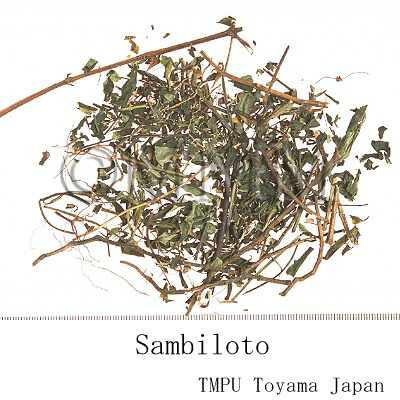Crude drug sample data base
※Click on the image to enlarge it.
Scientific information data base
| Crude drug name | Indonesian name, English name | Sambiloto | ||||
|---|---|---|---|---|---|---|
| crude drug image |
| |||||
| Original plant name | Andrographis paniculata Nees | |||||
| Family name | Acanthaceae | |||||
| Used part | Leaves | |||||
| Distribution area | It is cultivated as medicinal plants in Indonesia, and is very common locally, often gregarious. It has weedy characteristics and occurs from sea-level up to 1600 m altitude in roadsides, waste places field [201, 205]. | |||||
| Description | Leaves opposite; simple, narrowly ovate to lanceolate; basic long attenuate, apex long acuminate, margin entire, glabrous; petiole short and connected with the opposite ones by transverge ridges. The plant is a perennial herb 30-100 cm tall; stem 4-angular, glabrous except for the few hairs at the nodes. Flowers in lax, axillary and terminal racemes or panicles combined into a pyramidal inflorescence, corolla bilabiate white or rose with purple markings on the upper lip. Fruit an erect, many seeded [205]. | |||||
| Drug effect | Bitter, cooling, blood cleanser [231]. | |||||
| Specific actions | Anti-diabetes, anti-inflammatory, analgesic, stomachic [231]. | |||||
| Frequency in use | Abundant | |||||
| Pharmacological effect | A research has been conducted to evaluate the initial treatment of the common cold and sinusitis with A. paniculata leaves. It was concluded that the leaves have the capacity to significantly shorten the duration of common cold [205]. An ethanolic extract of A. paniculata administered orally to rats showed significant antipyretic activity [205]. The aqueous extract exhibit a dose-dependent hypotensive activity [205]. Methanolic extract of A. paniculata exhibited antioxidant and anti-inflammatory properties. It was shown also that the extract produced complete inhibition of caraagenan induced inflammation compared with control [PMID: 16684672]. On the evaluation of the anticancer and immunomodulatory activity of the methanolic extract of Andrographis paniculata in human cancer and immune cells , it showed that andrographolide has anticancer activity on diverse cancer cells representing different types of human cancers [PMID: 15138014]. Four xanthones have been isolated from the root of A. paniculata using column and thin layer chromatographic methods. In vitro study of their antimalarial activity have been conducted and result showed their anti-plasmodial activity against Plasmodium falciparum. In vivo anti-malarial sensitivity tests of the compounds with Plasmodium berghei infections using Peters' 4-day test gave substantial reduction in parasitaemia [PMID: 15507344]. Study on the hepatoprotective and antioxidant activity of Andrographis paniculate in BHC induced liver damage in rats showed that the treatment prevents BHC induced increase in the activities of enzymes y-Glutamyl transpeptidase, glutathione-S-transferase and lipid peroxidation. The result indicates antioxidant and hepatoprotective action of A. paniculata [PMID: 11349524]. | |||||
| Medical system | Indonesian medicine (Jamu) | |||||
| Traditional usage | It is used as a remedy against snake and insect bites. To cure snake bites, just chew a small amount of the plant parts, swallow the sap and apply the remaining waste material on the wound. In combination with Orthosiphon stamineus it is used to treat diabetes; an infusion or sap from pounded leaves is used for the treatment of fever, as a tonic and especially good for itching skin eruptions. A decoction of the leaves or roots is used against stomachache, dysentery, typhus, cholera, influenza and bronchitis, as a vermifuge, and diuretic. Pills or infusion from leaves are used to treat female disorders [201, 205]. | |||||
| Formulation | 1) Diabetes: 25 pieces of A. paniculata leaves and 25 pieces of Orthosiphon stamineus leaves are boiled with 110 ml of water. Stand to cool and strain. Drink 100 ml of the decoction [231]. 2) Typhus: 17 pieces of leaves is finely pounded, add some water if necessary, squeeze and drink the sap 1/4 cup once a day [231]. 3) Scabies (boils, sore, ulcer): A mixture of 7 pieces of leaves and 5 pieces of Plantago major is boiled with 110 ml of water, drink 100 ml of the decoction once a day for 14 days [231]. | |||||
| References | Reference book Tips! | [201] K. Heyne, Tumbuhan Berguna Indonesia, Vols. 1-4, 1987. Diedarkan Oleh Koperasi Karyawan Departemen Kehutanan, Jakarta, Indonesia. Vol. 3, p 1756. [205] de Pdua, L.S., Bunyapraphatsara, N. and Lemmens, R.H.M.J. (Editors), 1990. Plant Resources of South-East Asia No. 12 (1). Medicinal and poisonous plants 1. Backhuys Publishers, Leiden, Netherlands. pp 119-123. [231] Soedibyo, Mooryati: Alam Sumber Kesehatan: Manfaat dan Kegunaan (Natural resources for health. Benefits and uses). Balai Pustaka. 1998. pp 327-328. | ||||
| Research paper | 1. Sheeja K, Shihab PK, Kuttan G. Antioxidant and anti-inflammatory activities of the plant Andrographis paniculata Nees. Immunopharmacol Immunotoxicol., 28(1):129-40, 2006. (PMID: 16684672) 2. Dua VK, Ojha VP, Roy R, Joshi BC, Valecha N, Devi CU, Bhatnagar MC, Sharma VP, Subbarao SK. Anti-malarial activity of some xanthones isolated from the roots of Andrographis paniculata. J Ethnopharmacol., 95(2-3):247-51, 2004. (PMID: 15507344) 3. Kumar RA, Sridevi K, Kumar NV, Nanduri S, Rajagopal S. Anticancer and immunostimulatory compounds from Andrographis paniculata. J Ethnopharmacol., 92(2-3):291-5, 2004. (PMID: 15138014) 4. Trivedi NP, Rawal UM. Hepatoprotective and antioxidant property of Andrographis paniculata (Nees) in BHC induced liver damage in mice. Indian J Exp Biol., 39(1):41-6, 2001. (PMID: 11349524) | |||||
| Remarks | [DNA sequences] AJ973128, AJ973129, AJ973130, AJ973131, AJ973132, AJ973133 | |||||
| Last renewal date | 2024/03/13 | |||||





